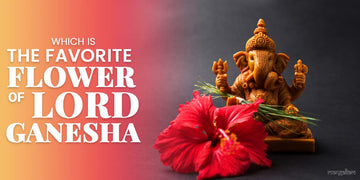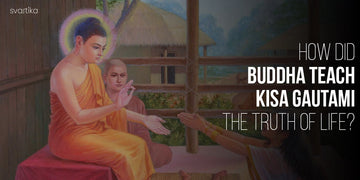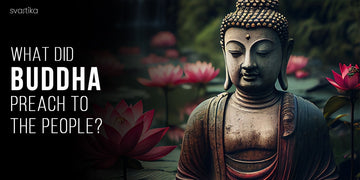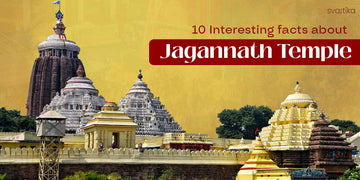Flowers are an essential component of every pooja and are one of the essential items to have in pooja room.
Flowers are a part of nature that provide scent and beauty, and their beauty adds to divinity. They always spread positive spiritual energies in the air.
Flowers, through their petals, attract subtle, heavenly particles in space and energise the environment with spiritual vibes.
Specific flowers can draw the principle of specific deities. The colour and scent of the flower have the potential to draw the deity's attention, which helps the worshipper.
Offering fresh flowers to God in the sense of sacrifice and devotion helps to improve a person's good energies or sattwic energies. The deity is pleased and bestows health, money, and success gifts.
Here you will find out about the favourite flower of Lord Ganesha. On Ganesh Chaturthi, worshippers can amaze Lord Ganesha by gifting him the flowers he prefers.
But you might be wondering which flowers are used for Ganesh Chaturthi. Don't worry! We will cover that here.
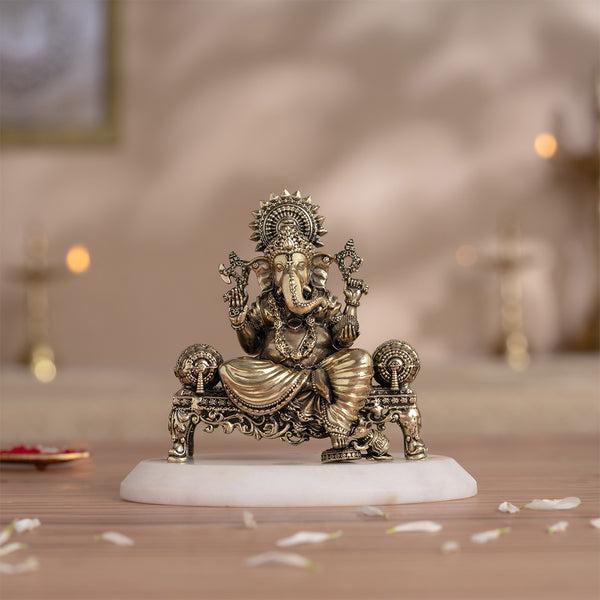
Brass Ganesh Idol Virajman On Sinhasan (4 Inch)
Which is the Favourite Flower of Lord Ganesha?

Lord Ganesha is the highest incarnation of Brahman, who eliminates barriers and brings success in all pursuits.
He is the Pranava Swarupa, the incarnation of the primal cosmic sound AUM. Before commencing any worldly, religious, or spiritual endeavour, he is summoned.
Red flowers are associated with Mars and the Moon. Lord Ganesha is especially pleased by red flower offerings.
Lord Ganesha loves red flowers. Hence we may say this flower is important to Ganapati. In Sanskrit, this is known as Japakusuma. It is presented for overall prosperity and enemy eradication.
Many individuals drink hibiscus powder, which is beneficial to the heart. There are several varieties with flower colours ranging from white to yellow and orange to scarlet and pink tones, as well as single and double sets of petals.
Lord Ganesha's favourite flower, hibiscus, is a popular decorative plant in the tropics and subtropics. Because it cannot resist temperatures below 10 °C (50 °F), it is best cultivated under glass in temperate climates.
Plants planted in pots can be left outside during the summer and brought inside during the winter.
Hibiscus is placed in the pooja room while worshipping Lord Ganesha murti in the household or temples by the devotees, since hibiscus is the favourite flower of lord ganesha.
This red hibiscus flowers are used in Lord Shiva idol pooja and placed in Shiva pooja room.
Ganesh Ji Favourite Flowers Used for Ganesh Chaturthi
1. Kunda (Downy Jasmine)

Kunda is one of the flowers offered for Ganesh Chaturthi. They are known as Nithya mulai and can be seen all year. It is provided to promote family togetherness.
Star Jasmine is another name for this. Downy jasmine plant is a prevalent landscape plant typically used in foundation plantings.
With a pure white star shape and lovely blooms, this plant emerges practically year-round, and its aroma is spectacular and cute. The leaves are oval with a rounded base.
Although jasmine blossoms are grown all across India, commercial production is concentrated in the states of Maharashtra, Uttar Pradesh, West Bengal, Rajasthan, Andra Pradesh, Karnataka, and Tamil Nadu.
2. Gokarna (Clitoria Tarnatea)

Lord Ganesha also likes the flower Gokarna. It is given in exchange for early marriage blessings. This flower is also known as Asian pigeonwings, butterfly pea, blue pea, and other names.
The most noticeable aspect of this plant is the colour of its blooms, which are a vibrant deep blue and solitary with faint golden lines.
It grows nicely as a vine or creeper in damp, neutral soil. Aside from adornment, it is a multi-utilitarian plant used for food, medicine, dye, and animal feed.
However, it is mostly planted in India as a medicinal herb and decorative climber. The root, bark, leaves, and seeds of this native medicinal plant are utilized in Ayurveda medicines.
3. Marigold

As we all know, Lord Ganesha loves red flowers, but the yellow saffron Marigold (Genda) flower is also on his list of favourite flowers.
In India, it is also known as Genda, Zendu, or Chendumalli. Offering this flower for good health is a tradition. Maharashtra, Karnataka, Gujarat, Andhra Pradesh, Tamil Nadu, and Madhya Pradesh are major marigold farmers in India.
Dashera and Diwali are two festivals when this crop is in high demand. Marigolds are durable, colourful, and easy-to-grow plants.
Marigold flowers is used in various pujas, marigold flowers seen to be used by devotees in decoration of krishna idol or any other idols.
Marigolds do not bloom all year, but with careful care, some types can last for months. They'll put on the finest show of the summer and into the fall.
Marigold has several therapeutic properties. Marigold has traditionally been used to soothe inflamed skin.
4. Sevanthi (Chrysanthemum)

Do you want to get rid of the evil eyes effect? Then, on Ganesh Chaturthi, present this flower. These small yellow flowers are provided to banish evil eyes and the negative effects of negative energies.
Sevanthi is a short-day plant, which means they bloom in the late summer, fall, and early winter when the days are shorter.
Aside from Ganesh Puja, there is a high demand for marigold flowers throughout holidays such as New Year's, Christmas, Mother's Day, etc. Angina, high blood pressure, fever, cold, headache, dizziness, and oedema are all treated with chrysanthemum.
This flower is also used to cure prostate cancer with other medicines. As a midsummer beverage, sevanthi is highly popular.
5. Parijatha (Coral Jasmine)

It is a lovely and intriguing plant, with blooms that fall to the ground after blossoming. Parijat, also known as Harsingar, is a flower suited for the gods.
The term 'Parijat' literally means "derived from" or "heavenly." Flowers blossom at night and fall off the trees in the morning light, leaving us craving more.
The Parijat flower is also known as Night-flying Jasmine and Coral Jasmine. It has a distinct aroma and is quite delicate. It is presented to Lord Ganesha for the youngsters to succeed in life.
It is recognised as a medicinal plant in various regions of the nation, including Assam and Bengal, and it is also utilised as an attractive flower.
Parijat or Jasmin is also a favourite flower of lord hanuman and it is placed near the hanuman idol in the pooja room by the devotees.
6. Arali (Olender)

It's a fragrant bloom on an evergreen shrub that may grow 18-20 feet tall. Although its seed and other portions are deadly, these flowers are commonly utilised in poojas.
In India, oleanders, known as kanagele, arali, ganneru, kaner, and raktakarabi, have delighted Indian gardens for ages.
Oleanders are often large, mounded bushes that dominate the landscape. Oleanders bloom in huge clusters of 2-inch single or double flowers from early summer to mid-autumn.
Despite the risks, oleander seeds and leaves are employed in medication production.
Closing Thoughts
Flowers add vibrance to any ritual, especially to festivals of deities. When you add flowers to your devotional journey, it makes the whole surrounding aromatic and makes you more devoted to God.
Lord Ganesha like many different flowers and red-coloured flowers are his favourite. Every flower has its own merits and reason to be offered. Before offering any flower, know its reasons and any particular precaution to follow.
This blog has discussed which flowers Lord Ganesha likes. Some flowers like Tulsi are not good options to offer in Puja. So, beware of offering them to Lord Ganesha.
Frequently Asked Questions
1. Why Does Lord Ganesh Like Hibiscus Flower?
Before undertaking any worldly, religious, or spiritual endeavour, Lord Ganesha is invoked. Offerings of red flowers make him very happy. Red flowers are associated with Mars and the Moon. That is why Ganapati enjoys the Red Hibiscus flower.
2. Which Flowers to Not Offer to Lord Ganesha?
Tulsi is commonly grown in the yards of Hindu families. It is often grown in sanctuaries. Ladies usually worship tulsi. The wilting individual is given tulsi leaves and Ganga Jal.
Tulsi is often used in pooja rites since it is considered India's most sacred plant. Conversely, Tulsi cannot be offered to Lord Ganesha since it is linked with a shared revile.
3. Why is Tulsi Not Offered to Lord Ganesha?
Tulsi is not presented to Ganesha since they are both cursed. Tulsi is Dharmaraja's daughter (God of righteousness).
In her youth, she was a devoted follower of Narayana (lord Vishnu). She was once wandering along the banks of the Ganges. She discovered the lovely Ganesha, who devoted deeply to Lord Vishnu.
Tulsi immediately fell in love with Lord Ganesha and wanted him to marry her. At the period, Lord Ganesha was a bachelor (brahmachari), as is customary for any meditator.
As a result, Lord Ganesha had no desire to marry anyone. Ganesha gently declined tulsi's marriage proposal. Her heart was broken. Tulsi viewed this as an insult and cursed Ganesha, saying he would marry against his will one day.
In return, Lord Ganesha cursed Tulsi, stating she would marry an asura (demon) and then become a plant with the blessings of the sages (or gods).


